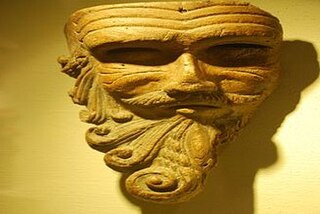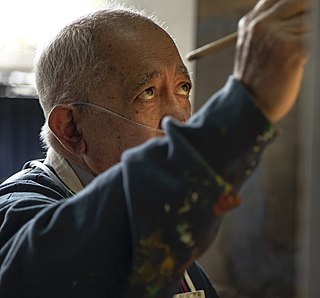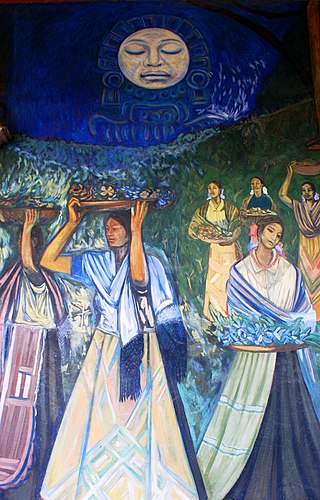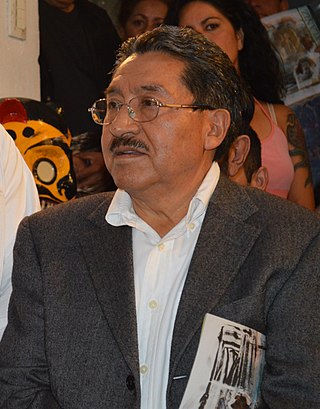Armando Romero (born 1964 in Mexico City, Mexico) is a Mexican painter. [1]
Armando Romero (born 1964 in Mexico City, Mexico) is a Mexican painter. [1]
Romero studied at the Escuela Nacional de Pintura, Escultura y Grabado "La Esmeralda", in Mexico City. From 1991 to 1997, Romero taught sculpture, painting and art history at La Esmeralda. Additionally, from 1991 to 1993, Romero taught art history, design, and drawing at the College Center for Studies in Science and Communications in Mexico City, and also in 2002 taught painting at the School for Visual Arts in Michoacán, Mexico.
In 1998, Romero represented Mexico in the Emerging Artists of Latin America exhibition at the Passage de Retz gallery in Paris, France, and in 2001 he lectured on sculpture and participated in the International Studio Program of the National Foundation for Advancement in the Arts in the United States.
A neoeclectic painter, Romero combines his versions of historic paintings by artists, such as Caravaggio, Rembrandt, Goya, and Bosch, with irreverent contemporary images, allowing emotion and reason free range. Armando Romero, also sculptor, has brought to the forefront the Mexican art, the only painter who had a solo exhibition at Zona Maco in Mexico City.

José Luis Cuevas was a Mexican artist, he often worked as a painter, writer, draftsman, engraver, illustrator, and printmaker. Cuevas was one of the first to challenge the then dominant Mexican muralism movement as a prominent member of the Generación de la Ruptura. He was a mostly self-taught artist, whose styles and influences are moored to the darker side of life, often depicting distorted figures and the debasement of humanity. He had remained a controversial figure throughout his career, not only for his often shocking images, but also for his opposition to writers and artists who he feels participate in corruption or create only for money. In 1992, the José Luis Cuevas Museum was opened in the historic center of Mexico City holding most of his work and his personal art collection. His grandson Alexis de Chaunac is a contemporary artist.

Arturo García Bustos was a Mexican painter and print maker. He is known as one of “Los Fridos” students who studied under Frida Kahlo at her home in Coyoacán.

Juan Soriano was a Mexican artist known for his paintings, sculptures and theater work. He was a child prodigy whose career began early as did his fame with various writers authoring works about him. He exhibited in the United States and Europe as well as major venues in Mexico such as the Museo de Arte Moderno and the Palacio de Bellas Artes. His monumental sculptures can be found in various parts of Mexico and in Europe as well. Recognitions of his work include Mexico's National Art Prize, the Chevalier des Arts et Lettres and membership in France's Legion of Honour.

Rafael Coronel was a Mexican painter. He was the son-in-law of Diego Rivera.

Fernando Castro Pacheco was a Mexican painter, engraver, illustrator, printmaker and teacher. As well as being known for traditional artistic forms, Castro Pacheco illustrated several children’s books and produced works in sculpture. He is more popularly known for his murals that invoke the spirit and history of the Mexican people. His works evoke a unique use of color and form.
Carlos Orozco Romero was a Mexican cartoonist and painter who co-founded several cultural institutions in Mexico, including the Escuela Nacional de Pintura, Escultura y Grabado "La Esmeralda". His work was recognized with membership in the Academia de Artes and the Salón de la Plástica Mexicana, and in 1980, with Mexico's Premio Nacional de Arte.

Gilberto Aceves Navarro was a Mexican painter and sculptor and a professor at the Escuela Nacional de Artes Plásticas and Academy of San Carlos. There have been more than two hundred individual exhibits of his work, with his murals found in Mexico, Japan and the United States. He received numerous awards for his work including grants as a Creador Artístico of the Sistema Nacional de Creadores de Arte, Premio Nacional de Ciencias y Artes and Bellas Artes Medal from the Instituto Nacional de Bellas Artes.

Sandra Pani is a Mexican artist.

Alfredo Zalce Torres was a Mexican artist and contemporary of Diego Rivera, David Siqueiros and other better-known muralists. He worked principally as a painter, sculptor, and engraver, also taught, and was involved in the foundation of a number of institutions of culture and education. He is perhaps best known for his mural painting, typically imbued with "fervent social criticism". He is acclaimed as the first artist to borrow the traditional material of coloured cement as the medium for a "modern work of art". Publicity-shy, he is said to have turned down Mexico's Premio Nacional de Ciencias y Artes before finally accepting it in 2001. Before his death, Sotheby's described him as "the most important living Mexican artist up to date".
Lilia Carrillo García was a Mexican painter from the Generación de la Ruptura, which broke with the Mexican School of Painting of the early 20th century. She was trained in the traditional style but her work began to evolve away from it after studying in Paris in the 1950s. While she and husband abstract artist Manuel Felguérez struggled to get their work accepted, even selling Mexican handcrafts and folk art to survive, she eventually had her canvas work exhibited at large venues in Mexico City and various cities in the world. Her work was part of the inaugural exhibition of the Museo de Arte Moderno in Mexico City in 1964. After her death in 1974, her work received honors from the Palacio de Bellas Artes and has been exhibited in various venues.
IGNACIO ORTIZ CEDEÑO

Deyanira África González Melo is a Mexican sculptor who generally works in ceramics, depicting elements of the human form, especially the torso, generally with mutilations and other disturbing elements to dispute the otherwise traditional and sensual depictions of the human body. She has exhibited her work since studying at the Escuela Nacional de Artes Plásticas (ENAP) in Mexico as well as in Europe and the Caribbean. Her work has received recognition in Mexico and abroad, and is a member of the Salón de la Plástica Mexicana.
Olga Dondé was a Mexican artist involved in various fields but best known her still life pieces. She was a self-taught painter, who worked for two years until she decided to enter works in a show in 1968. From then she had about 100 showings of her work, including more than forty individual exhibitions in Mexico, the United States, South Americana and Europe. She also founded artistic organizations, an art gallery and a publishing house. Dondé’s work was recognized by admission in the Salón de la Plástica Mexicana, among other honors and her work continues to be shown and honored after her death.
Tomás Parrá is a Mexican artist, cultural promoter and museum curator. His work has been noted with membership into Mexico Sistema Nacional de Creadores de Arte.
Mario Reyes Castillo (1926–2017) was a Mexican printmaker, painter and sculptor best known for his work with the Taller Libre de Grabado Mario Reyes, which he founded in 1965. This workshop has collaborated with and done work for a number of notable Mexican artists. Much of his artwork was dominated with depictions of the female form, with the artist stating he could see it in many places and objects. His work has been recognized with tributes and retrospectives in places such as the Museo Nacional de Estampa and the Palacio de Bellas Artes. He was also a member of the Salón de la Plástica Mexicana.

Hermenegildo Sosa is a Mexican painter and art professor who is best known for colorful depictions of Mexican rural landscapes, especially those of his home state of Tlaxcala. He was born there into a farming family, whose economic condition delayed his education as he had to work from a young age. In his teens he arrived to Mexico City to work as a domestic, but this allowed him to attend school, including painting classes. Eventually, he entered the Escuela Nacional de Pintura, Escultura y Grabado "La Esmeralda", where he eventually gained a career as a professor.
Sergio Valadez Estrada is a Mexican painter, sculptor and musician based in France. His themes are mostly related to life in Paris, but with a Mexican artistic perspective. His work has been shown regularly in several countries, especially France and Mexico, and he has been recognized with membership in the Salón de la Plástica Mexicana.

Claudia Alvarez is a Mexican American painter and sculptor who has worked as an artist in residence in Mexico, Switzerland, France, and China. Alvarez's solo exhibitions include Claudia Álvarez: A Moment in Between at the Acércate at the National Arts Centre, Mexico City; Girls with Guns, Scott White Contemporary Art, La Jolla, California; Falling, Museum of Nebraska Art, Kearney, Nebraska; Silence Water, Museum of Art Contemporary Yucatán, Mérida; American Heroes, Blue Leaf Gallery, Dublin; Things of a Child, The Latino Museum, Omaha, Nebraska; and History of Immigration, Metropolitan Community College, Omaha, Nebraska. Alvarez is based in New York City.

Carlos Medina is a Venezuelan-born France-based visual artist primarily known for his minimalist geometric compositions and significant spatial interventions, which combine sculpture techniques and plastic arts. He has had over twenty exhibitions in museums worldwide, and his works are present in collections, and public spaces, in countries such as Italy, France, Belgium, Yugoslavia, the United States, South Korea, Austria, Hungary, Spain, Mexico, Chile, Argentina, Colombia, Panama, Costa Rica, and Venezuela.

Perla Krauze Kleinbort is a Mexican sculptor, painter and visual artist. She has a Masters in Visual Art from Chelsea College of Art, in London. Her work is important public collections such as the Museo de Arte Moderno in Mexico City, the Museo de Arte Contemporaneo/ Museum of Contemporary Art in Oaxaca City, Museo de Arte Carrillo Gil/ Carrillo Gil Art Museum, Museo de la Secretaría de Hacienda y Crédito Público and the Scottsdale Museum of Contemporary Art in Arizona.